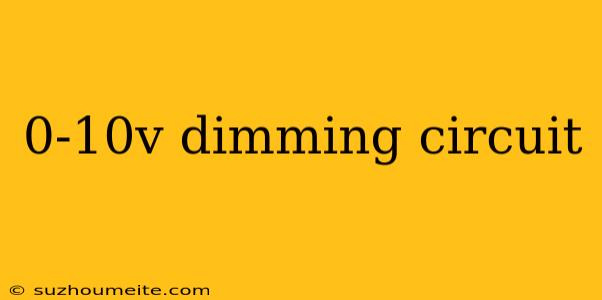0-10V Dimming Circuit: A Comprehensive Guide
Introduction
Dimming circuits are essential components in various applications, including lighting systems, LED drivers, and motor control systems. One of the most popular dimming protocols is the 0-10V dimming circuit, which is widely used in industrial, commercial, and residential applications. In this article, we will delve into the world of 0-10V dimming circuits, exploring their working principle, advantages, and applications.
What is a 0-10V Dimming Circuit?
A 0-10V dimming circuit is a control system that uses a 0-10V analog signal to control the brightness of a light source, such as LEDs or fluorescent lamps. The circuit consists of a dimmer switch, a power supply, and a load, which can be a light source or a motor. The dimmer switch produces a 0-10V DC output signal that is proportional to the desired brightness level.
Working Principle
The 0-10V dimming circuit works on the principle of pulse-width modulation (PWM). When the dimmer switch is adjusted, it produces a PWM signal with a fixed frequency and varying duty cycle. The duty cycle of the PWM signal determines the average voltage output, which in turn controls the brightness of the light source.
Here's a simplified explanation of the working principle:
- Dimmer Switch: The dimmer switch is adjusted to the desired brightness level, which corresponds to a specific voltage output (0-10V).
- Power Supply: The power supply provides a stable DC voltage to the circuit.
- PWM Signal: The dimmer switch produces a PWM signal with a fixed frequency (typically 100-200 Hz) and varying duty cycle.
- Output Voltage: The PWM signal is filtered to produce a 0-10V DC output voltage, which is proportional to the desired brightness level.
- Load Control: The 0-10V output voltage controls the brightness of the load (light source or motor).
Advantages
0-10V dimming circuits offer several advantages, including:
Flexibility
0-10V dimming circuits can be used with a wide range of loads, including LEDs, fluorescent lamps, and motors.
Easy Installation
The circuit is relatively simple to install and requires minimal wiring.
High Accuracy
The circuit provides high accuracy and precision control of the load.
Low Power Consumption
The circuit consumes low power, making it energy-efficient.
Applications
0-10V dimming circuits have a wide range of applications, including:
Lighting Systems
The circuit is widely used in commercial and residential lighting systems, including LED strips, fluorescent lamps, and HID lamps.
Motor Control
The circuit is used in motor control systems, such as speed control of fans, pumps, and compressors.
Industrial Automation
The circuit is used in industrial automation applications, such as process control and monitoring systems.
Conclusion
In conclusion, 0-10V dimming circuits are widely used in various applications, offering flexibility, ease of installation, high accuracy, and low power consumption. By understanding the working principle and advantages of 0-10V dimming circuits, designers and engineers can specify and design efficient and effective control systems.
